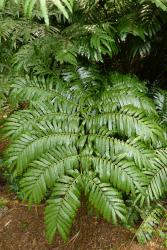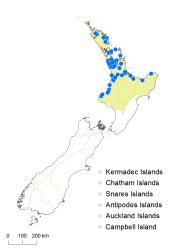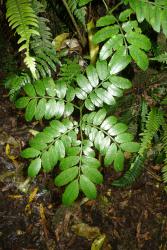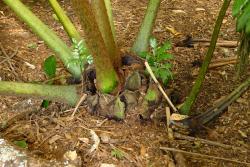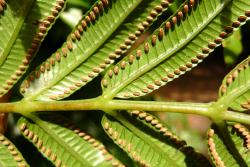- Taxon
- Gallery
- ≡ Marattia salicina Sm. in Rees, Cycl. 22 (1812)
Rhizomes short, erect, forming a hard mass, with pairs of large ear-like lobes protecting new fronds. Fronds 2000–2800 mm long (up to 4000 mm in cultivation). Stipes 1000–1500 mm long, 30–40 mm in diameter at base above swollen junction with rhizome, not winged, green, smooth except for abundant, very narrowly ovate, fimbriate, non-clathrate scales up to 15 mm long, 1.5 mm wide. Laminae 2-pinnate, ovate, 1100–1400 mm long (up to 3000 mm in cultivation), 1100–1500 mm wide (up to 2000 mm in cultivation), dark glossy green on upper surfaces, paler on lower surfaces, coriaceous; scales abundant on abaxial surface of rachis, pinna midribs and costae, narrowly ovate to linear, pale brown, fimbriate. Primary pinnae in 6–11 pairs, oblong, the longest 385–650 mm long, 155–330 mm wide, stalked; pulvini present at the junction with rachis. Secondary pinnae in 13–24 pairs, narrowly oblong or narrowly ovate, the longest 95–185 mm long (205 mm in cultivation), 13–23 mm wide, shortly stalked; apex attenuate to acuminate; margins serrate or serrulate; base unequal, cuneate to truncate; pulvini present but obscure at the junction with pinna midrib. Veins free, undivided or occasionally 1-branched. Synangia oblong with rounded ends, 1.5–3.5 mm long, on veins just inside the pinna margin, comprising 2 rows of 5–14 fused sporangia; paraphyses present as very narrow, hair-like scales surrounding the synangia.
This species is easily recognised by its very large fronds growing from a low, compact rhizome. The laminae are always bipinnate, with swellings (pulvini) at the junctions of the primary pinnae and rachis. The sporangia are characteristically fused into synangia and open by lengthwise slits, unlike any other fern in New Zealand. In dry conditions, water is lost preferentially from the pulvini causing the pinnae to droop vertically in dramatic fashion.
Ptisana salicina has been confused with P. oreades (Domin) Murdock, which is endemic to eastern Queensland and readily distinguished by a prickly stipe. It is also closely related to P. smithii (Mett. ex Kuhn) Murdock from Vanuatu, Fiji, Samoa and Tonga, which generally has more deeply serrate pinnules, especially in juvenile fronds, and synangia that are 2–4 mm from the margin. P. howeana (W.R.B.Oliv.) Murdock, endemic to Lord Howe Island, has longer synangia with 15–22 pairs of sori, and secondary pinnae that are glabrous on the underside (Green 1994).
North Island: Northland, Auckland, Volcanic Plateau, Gisborne, Taranaki.
Altitudinal range: 0–400 m.
Confined to coastal and lowland regions of the North Island, extending locally to mid-elevations in the Kaimai Ranges and Mt Pirongia. The species is found throughout Northland and Auckland, the Bay of Plenty as far east as Waihau Bay and the Waioeka Gorge, and in Taranaki south to the Kaitake Range, Egmont National Park.
Collections in MPN, NZFRI, and WELT from south of Taranaki (e.g. Kapiti, Wellington, Marlborough Sounds, Palmerston North areas) are likely to have been from cultivated plants.
Also Norfolk Island, New Caledonia, Cook Islands, Austral Islands, Society Islands, Marquesas Islands. Murdock (2008a) suggested that the species may also be present in the Eungella Range of Queensland, Australia.
Occurs in kauri, podocarp and broadleaved forest, often in deep, shaded gullies or on the banks of streams and creeks, especially where it is secure from stock and pigs.
The species was given a conservation status of declining by de Lange et al. (2013). It was once common in northern New Zealand, but is palatable to stock and has been decimated by pigs.
n = 39 (Brownlie 1961).
Ptisana salicina was previously thought to be confined to New Zealand and Norfolk Island (Green 1994; Brownsey & Smith-Dodsworth 2000). However, Murdock (2008a) reduced Marattia stokesii E.D.Br., M. cincta Copel. and M. grantii Copel. to synonymy and extended the distribution of P. salicina to include New Caledonia, the Cook Islands and French Polynesia. However, he conceded that it "likely encompasses several distinct taxa". New Zealand plants were widely misidentified in earlier literature as Marattia fraxinea Sm., but that species is now believed to be confined to Africa, Madagascar, the Indian Ocean and India (Murdock 2008a).
Ptisana salicina, or para, was cultivated by Māori, and the large stipules on the rhizome were considered a delicacy (Crowe 1981).
The species is cultivated in many botanic gardens in New Zealand where it frequently grows much larger than any known plants in the wild.



